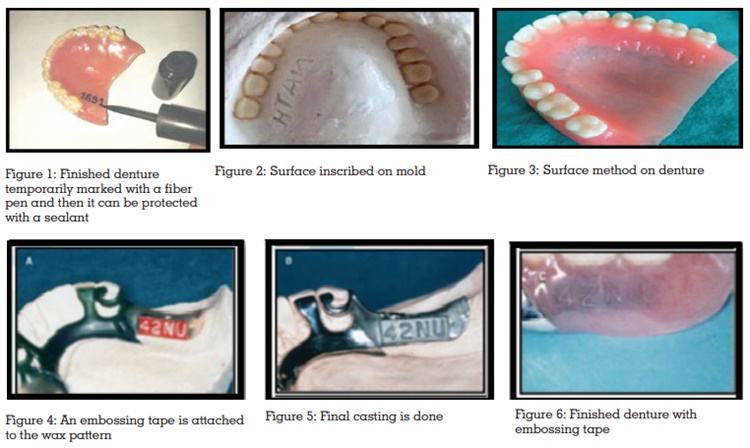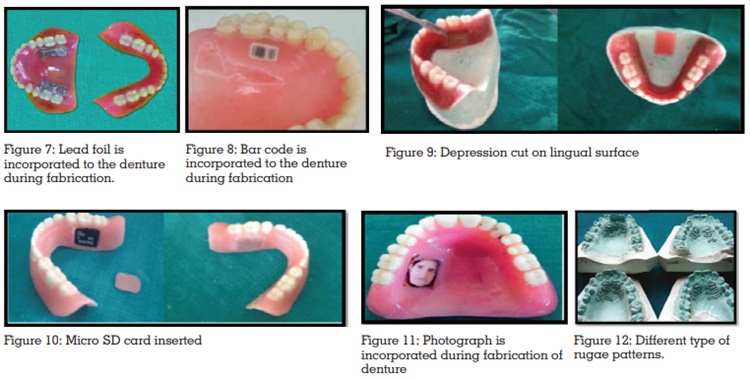Abstract:
Forensic odontology is an innovative branch in
dentistry. Forensic is derived from the Latin word
‘forum’ which means ‘court of law’.it play a key role
in establishing person’s identity. The dental anatomy
is so unique, so it required a good knowledge about
the dental science. It is a weapon against the
increasing crime rates. This article is a review about
the lethal role of forensic odontology in medicolegal cases and different techniques that are used.
Key words: odontology, denture marking,
forensic dentistry.
Introduction:
Harvey defined forensic dentistry as the branch of
forensic medicine which in the interest of justice,
deals with the proper handling and examination
of dental evidence with the proper evaluation
& presentation of dental findings. The forensic
dentist plays a crucial role in the identification of
deceased individuals. The ability to recognize,
preserve, organize & document such information
is the heart of forensic dentistry. Dental structures
are the hardest tissues of human body and will
survive longer than any other body tissues. The materials used in restoration of the teeth
are extremely resistant to destructive agents.
Hence in deceased individual’s identity can be
retrieved based on the assessment of prosthodontic
appliances. Identification of persons will be difficult
in situations like natural calamities, road traffic
accidents, mass disaster, or in act of terrorism.
So in such situation we can make use of DNA
comparison, visual identification, dental records
and finger prints.
Requirements for ideal markings:
- The strength of the prosthesis must not be
compromised.
- It must be easy and cheap or inexpensive to
apply.
- The identification system must be efficient.
- The marking must be visible and durable.
- The identification should withstand fire and
humidity
- The identification mark should be aesthetically
acceptable.
- The identification should remain inert
Classification for different types of
denture labeling systems:
Dental identification plays a key role in disaster
situations, and in particular, the mass casualties.
The denture marking plays an important role in
Forensic dentistry.
There are two types of denture marking available:
the surface marking method and the inclusion
method.
Surface Method
This is easy to apply and relatively inexpensive and
simple, but they wear off very easily. Scribing or
writing on tissue surface of denture or embossing
details in the master cast so as to replicate in
denture. The main disadvantages are food
accumulation and can cause infection. Surface
method can be done with embossing, engraving
or scribing
- Writing: It involves slight disking of the posterior
flange of the denture (non–tissue-bearing side),
marking the patient’s name and service number on
the roughened surface. Stevenson (1987) suggests
that rubbing an ink pen over the grooves which
are created will make it more evident.
Heath et al suggested a method in which the
roughened surface of finished denture can
temporarily marked with a fiber pen and then it
can be protected with a sealant (figure 1).
- Scribing and Engraving: This system involves
marking the letters in the models so that denture
carries the identification marks upon fabrication
(figure 2)
It can be done with a round bur on fitting surface
of the denture result in a counter sink letter.

- Embossing:-it is scratching model before
processing, it can be used in removable partial
denture, an embossing tape can attach to wax pattern (figure 4)and final casting is done (figure
5), so the plate will be visible through the acrylic.
(figure 6).
Inclusion method:-
The marks should be enclosed in the denture. This
should not affect the retention of the denture. The
preferred area is the palate and posterior region
of the lingual flange. So this will not be visible
while patient wear that. As this is embedded within
denture they are protected in case of fire.
Methods of intrusion
- ID bands
Dentures may be marked with stainless steel
band. The most commonly used materials are
HO matrix band and titanium foil which containing
an identifiable coding system. This material is
fire resistant.
- Lead paper label and radiograph
Lead foil found in intra oral x-ray can be used to type the patient details with ribbon type writer. It
can be in cooperated during time of fabrication of
denture or after processing of denture by cutting
a depression then by covering it with light cure
acrylic resin of same color (figure 7).
- Bar coding
A machine readable code of series of bars and
spaces printed in defined ratios. It can be placed
inside acrylic resin while processing can be also
used along with crowns (figure 8). It is technique
sensitive .it will get damaged above a temperature
of 200-300°c.
- T Bar
It was introduced by Ryan (1993). A T shape clear
PMMA resin bar and identification printed label
is made on the flat section of bar. This is attached
to the T bar by bonding agent and curing it.
The thickness of block should be less as possible,
so as to include it in to the groove that is created in
the denture. The surface is polished for the clear
display of T bar.
- Computer printed denture micro
labeling system
It was introduced by Berry et al 1995. A label
containing patient details was computer generated
and placed in slot in denture followed by saturated
clear resin polymer to seal it and curing is done.
(figure 9 and 10)

- Radiofrequency identification tags
This system consists of a data carrier, tag and
electronic handheld reader. This reader energizes
the transponder by means of an electromagnetic
field emitted by reader antina. It then receives
signals from transponder and it is then converted
to a readable data.
-It is stable at high as well as low temperature
(i.e. subzero to burning at 1500°c for 1 hr).
Disadvantages are high cost, not available in
most of the dental set up.
- Photograph
This technique is used in country where literacy
rate is low. Photograph can be embedded in clear
acrylic denture base (figure 11). Disadvantage is
that it will not resist heat beyond 300°c.
- Laser etching
Copper vapor laser that can etch a patient
identification on to the metal surface of partial
denture. This method needs specialized equipment
it is very expensive and required experienced
technician.
- Lenticular system
This was introduced by Colvenkar in 2010. In this
technique a lenticular lens is used to produce
image with an illusion of ability to change or move
as it is viewed from different angles. The images
are printed on a black synthetic paper and it is
laminated on a lens. Disadvantages –information
can never be changed, it cannot withstand heat or fire.
OTHER METHODS
- Palatine rugae pattern
Palatal rugae is known as the anatomical
wrinkles or fold called as plica palatine (figure
12). Ruage pattern are unique. It can be studied
by palatoscopy methods which include intra
oral examination, study of model, rugoscopy. Its
anatomical position in mouth will protect them from
high temperature and truma. Rugae inside mouth
is surrounded by tongue, buccal pad of fat, check,
lip, teeth and bone. Length of palate increase with
age but remains in same position throughout life, it is formed in 12 -14 week of prenatal life and
remain stable until degeneration of oral mucosa
after death.
DENTAL IMPLANTS
In situation where the body of victim has be
incinerated, there will be no scientific identifier
because of loss of tooth, fingerprints, denaturing
of DNA. The only available details will be
characteristics of recovered implants. The property
of an implant material such as high structural
strength, high melting point will help them to with
stand most of the unfavorable situations.
CHELIOSCOPY
It is the study of lip prints, i.e. The elevation
and depression which form the characteristics
features of lip. Edmond Locard (1932) is the first
person who suggested use of lip prints in crime
identification. Figuralineariumrubrorum is the
new name suggested by Suzuki and tsuchihasi
for lip prints. Lip prints can be obtained by direct
and indirect methods.
BITEMARK ANALYSIS
The dentition will be different for each person. The
missing or prominent tooth in dental arch help easy
identification of bite mark there by the culprit. The maxillary and mandibular teeth are found to be
the main factor in causing bite mark. Each bite
mark will differs according to the texture of skin.
Most commonly found bite mark is contusion. Bite
mark will reduce size within 10-20 min so the initial
documentation should be done at initial stage by
forensic dentist.
DNA
Deoxyribo nucleic acid is an evident tool in
identifying the culprit. DNA can be isolated from
saliva, organic substance like tooth, body tissue,
bone and blood.
CONCLUSION
A prosthodontist plays a vital role in forensic
identification. In some circumstances visual
identification, fingerprints and DNA identification
are not possible so the dental identification will
be successful because of its resistance nature to
incineration, trauma, mutilation. This is done by
comparing postmortem details with ante mortem
details. So it is the duty of dental professional
to keep dental notes, radiographs, study model,
clinical photograph etc. which will aid in
identification of a victim.
REFERENCES
- Mário marques fernandes, rachelribeirolimatinoco,
luizrenatoparanhos, luizfrancesquini junior,
eduardodarugejúnior. Prosthodontists’ perception of
the forensic dentistry aspects of dental records..Rgo - rev
gaúchaodontol. Porto alegre, v.61, n.3, p. 357-362, jul./
set., 2013.
- Dr. Roohikapoor, dr. Ravpreetsingh, dr. Kavipalsingh, dr.
Kamleshwarkaur“denture marking” a novel concept in
human identification..Iosr journal of dental and medical
sciences (iosr-jdms) e-issn: 2279-0853, p-issn: 2279-0861.volume 14, issue 3 ver. I (mar. 2015), pp 67-70.
- Drbaljindersingh, drnavroopbatth, drkaranprakashsingh
and drharleenkaur .Palatal rugae a finger print of oral
cavity..journal of dental science 2015.
- Vagishkumar, shanbhag. Significance of dental records
in personal identification in forensic sciences. Journal of
forensic science and medicine ¦ january 2016 ¦ volume
2 ¦ issue 1
- Sunil kumarmishra, harsh mahajan, rupalsakorikar,
anoopjain .Role of prosthodontist in forensic odontology.
A literature review.journal of forensic dental sciences /
september-december 2014 / vol 6 / issue 3.
- Pankajdatta, soniasood, poojarastogi, kalyanibhargava,
deepakbhargava, mukeshyadav.DNA profiling in forensic
dentistry. J indianacad forensic med. April-june 2012,
vol. 34, no. 2.
- dhakshaini, ashishsatpathy.Contribution of a
prosthodontist in the field of forensic odentology.
international journal of prosthodontics and restorative
dentisty, april-june 2014;4 (2);56-59.
- Ramasamy Chidambaram .Forensic odontology: a boon
to community in medico-legal affairs., jnmaivol 54 i no.
1 i issue 2011jan-mar 2016.
- sylvielouiseavon, dmd, msc. Forensic odontology: the
roles and responsibilities of the dentist.journal of the
canadian dental association. July/august 2004, vol. 70,
no. 7
- Joyce thomas, alexmathewmuruppel, dinesh n,
sheebagladstone, noxygeorgemanjuran. Dentures in
forensic identification- a review of methods & benefits.
J adv med dent scie 2014;2(1):85-94.
- Sumalatha s., padmaja s., prafullathumati. Every contact
leaves its trace”-insight intorecent advances of forensic
odontology”.Journal of cancer treatment and research.
Vol. 3, no. 1, 2015, pp. 1-7. Doi: 10.11648/j.jctr.20150301.11.
- Corina Laura Stefanescu, Marius Florentin Popa, LaviniaSimonaCandea, IonutParlica .Study on forensic dental
identification methods by labeling prosthetic restorations.
J Leg Med 37-42 [2015].
- sulekhagosavi, siddharthgosavi. Forensic odentology
:a prosthetic view .J forensic Dent Sci 2012 jan –jun
;4(1):38-41
- paul G stimson .Forensic odentology .j prost dent .dec
1973, vol30, issue6, pages 922-925.



